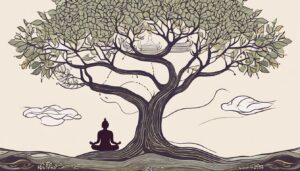The Illusion of Non-Thought: A Journey into Consciousness
The story opens with a question that challenges the very core of our being: “How long has it been since you were last lost in thought?” This seemingly innocuous inquiry sets the stage for a profound exploration into the nature of consciousness and self-awareness.
The narrative unfolds with a woman proclaiming a week of thoughtlessness, believing her mind to be in a state of pure consciousness. However, a subtle intervention by Tulku Urgyen pierces through the illusion, revealing the woman’s incessant mental chatter disguised as enlightenment. The danger of self-deception looms large as the façade of enlightenment crumbles, exposing the need for a deeper understanding of the mind.
Dzogchen, as taught by Tulku Urgyen, emphasizes the intrinsic selflessness of awareness, challenging practitioners to embody mindfulness as a means of dispelling the illusion of the self. The goal of Dzogchen is not an elusive state to be achieved but a way of being to be cultivated in every moment.
 The narrative further delves into the transformative power of direct instruction, exemplified by the author’s encounter with Tulku Urgyen. Through a clear and precise teaching, the illusion of the self is shattered, offering a path to liberation from psychological suffering.
The narrative further delves into the transformative power of direct instruction, exemplified by the author’s encounter with Tulku Urgyen. Through a clear and precise teaching, the illusion of the self is shattered, offering a path to liberation from psychological suffering.
The practice of Dzogchen is portrayed as a direct and unambiguous journey towards self-realization, emphasizing the need for a qualified teacher to guide seekers through the intricacies of awareness. The narrative underscores the importance of discernment in seeking spiritual teachings, urging practitioners to demand clarity in their practice and steer clear of vague or paradoxical ideologies.
Exploring the Depths of Consciousness: A Journey into the Beyond
The article delves into the profound teachings of Dzogchen, inviting readers to contemplate the nature of consciousness beyond the realm of duality. It prompts introspection by encouraging individuals to recall both pleasant and unpleasant experiences and observe how these memories evoke feelings in the present moment. The analogy of images appearing on a mirror is used to elucidate the transient nature of thoughts and emotions that arise in consciousness.
Central to the practice of meditation in Dzogchen is the recognition that consciousness remains untainted by the ever-changing landscape of thoughts and emotions. The article stresses the importance of closely examining the contents of consciousness and breaking the identification with transient thoughts. By allowing experiences to unfold without grasping or aversion, practitioners can discover the inherent freedom that exists within consciousness itself.
The essence of true meditation is revealed as the direct realization of the undivided nature of consciousness, independent of the ebb and flow of mental phenomena. Through the practice of resting in natural awareness, individuals can transcend the illusion of the self and recognize the seamless unity between perception and consciousness. This shift in perspective is not merely a cognitive exercise but a profound insight that transcends ordinary thought processes.
A key practice highlighted in the article involves turning consciousness inward to investigate the nature of the self. By examining the perceived divide between subject and object, individuals can challenge the fundamental sense of ‘I’ and explore the illusory nature of self-identification. The possibility of failing to locate the elusive ‘I’ is presented as a transformative experience that culminates in a deep realization of the nature of consciousness.
In essence, the article serves as a guide to unraveling the layers of duality that cloud our perception of reality. By immersing oneself in the practice of meditation and self-inquiry, one can uncover the boundless freedom that resides within the essence of consciousness itself, transcending the limitations of the egoic self. This journey into the depths of consciousness offers a pathway towards liberation and self-realization, inviting readers to explore the profound wisdom of Dzogchen teachings.
The Path to Selflessness: An Exploration of Douglas Harding and Meditation
The article delves into the life and insights of British architect Douglas Harding, who ventured into the realm of selflessness through a profound experience he termed as “having no head.” Drawing parallels between Harding’s teachings and the principles of Dzogchen practice, the narrative unfolds to unravel the nature of consciousness and the illusion of the self.
Harding’s transformative journey, sparked by a simple self-portrait by physicist Ernst Mach, paved the way for a deeper understanding of consciousness and identity. His exploration culminated in a state of awareness devoid of self-representation, encapsulated in his book “On Having No Head.” Through his work, Harding sought to guide individuals towards a direct experience of selflessness, akin to the essence of Dzogchen practice.
The narrative transitions to an exploration of meditation, shedding light on the wandering nature of the human mind and its correlation with brain activity. Studies on mindfulness and neuroplasticity reveal the profound impact of meditation on brain structure and function. From reducing stress-related inflammation to enhancing pain tolerance, meditation emerges as a powerful tool for physical and mental well-being.
The article reflects on the paradox of spiritual seeking, emphasizing the dichotomy between the paths of gradual ascent and sudden realization. While gradual practices offer a structured approach to self-transcendence, the path of sudden realization challenges the notion of effort and attainment in spiritual growth. The narrative underscores the intrinsic freedom of consciousness in the present moment, advocating for a shift in perspective that transcends the illusion of the self.
Through introspective reflections on meditation and self-awareness, the article invites readers to explore the boundless nature of consciousness beyond the constructs of the ego. Embracing the journey towards selflessness and inner liberation, individuals are encouraged to discover the transformative power of mindfulness and the profound wisdom hidden in the depths of their own awareness.
In essence, the article serves as a beacon of guidance through the realm of self-discovery and spiritual awakening. By delving into the teachings of Douglas Harding and the transformative potential of meditation, readers are invited to embark on a profound journey towards selflessness and the intrinsic freedom of consciousness.
Exploring the Path of Enlightenment: Insights from Eastern Wisdom
The article delves into the personal journey of the author as he navigates the realms of spiritual seeking and self-discovery through encounters with Indian spiritual teachers. It begins with the author’s reflections on his pursuit of the goal of cessation through silent retreats and meditation practices. Despite experiencing moments of profound peace and the absence of self-representation, the elusive state of cessation remained unattainable, leading to a sense of frustration and contemplation.
The narrative takes a transformative turn when the author meets H. W. L. Poonja, also known as Poonja-ji, a disciple of the revered sage Ramana Maharshi. Ramana’s extraordinary awakening experience and teachings on self-inquiry and the nature of consciousness serve as a guiding light for spiritual seekers. Embracing the essence of Advaita philosophy, Ramana emphasizes the illusory nature of the ego and the intrinsic freedom of consciousness beyond the limitations of self-perception.

Through Poonja-ji’s uncompromising teachings on nonduality and the nature of experience, the author is exposed to a new perspective on enlightenment. Poonja-ji’s unwavering stance on the illusory nature of the self and the inherent freedom of consciousness challenges traditional dualistic practices, inviting seekers to delve into the depths of their awareness. The author’s encounter with Poonja-ji sparks a profound shift in his spiritual journey, highlighting the power of direct experience and self-inquiry in unraveling the mysteries of consciousness.
However, the narrative also delves into the potential pitfalls of absolute nondualism, as witnessed through fellow students who claim enlightenment without embodying the qualities of true wisdom. The challenges of discerning genuine spiritual realization from delusion in the quest for enlightenment come to the forefront, raising questions about the nature of spiritual authority and self-realization. The author grapples with the complexities of spiritual attainment and the fine line between true insight and illusion in the realm of Eastern wisdom traditions.
Unveiling Illusions in the Pursuit of Enlightenment: A Journey of Spiritual Insight
The article delves into a transformative episode where the flaws in spiritual teachings become glaringly evident through the experiences of a group of practitioners seeking enlightenment under the guidance of renowned teachers. A woman attains what seems like enlightenment in the presence of Poonja-ji, celebrated as the epitome of spiritual realization without the need for meditation. However, the true nature of her enlightenment is put to the test when she encounters Tibetan Buddhist teachings of Dzogchen under Tulku Urgyen Rinpoche.
The narrative unfolds as the woman’s self-proclaimed enlightenment crumbles under the scrutiny of Tulku Urgyen, who challenges her perception with profound insight. The contrast between the teachings of Advaita Vedanta and Dzogchen illuminates the pitfalls of delusion that can arise from incomplete spiritual understanding. The essence of Dzogchen, emphasizing the practice of selflessness and dispelling illusions of the self, starkly contrasts with the notion of effortless enlightenment propagated by Poonja-ji.
Tulku Urgyen’s precise guidance in revealing the nature of consciousness as intrinsically free of self signifies a paradigm shift in the author’s spiritual journey. The practice of Dzogchen, rooted in recognizing nondual awareness in every moment, transcends traditional meditation techniques by integrating the goal of selflessness into the path itself. The clarity and directness of Tulku Urgyen’s teachings resonate as a transformative experience, enabling the author to dispel illusions of the self and access moments of profound freedom from psychological suffering.
The narrative underscores the significance of clear instruction and expert guidance in the pursuit of spiritual realization. Tulku Urgyen’s ability to transmit wisdom with precision and matter-of-factness contrasts with vague or paradoxical teachings prevalent in some spiritual lineages. The analogy of perceiving the optic blind spot elucidates the transformative impact of accurate guidance in spiritual practice, emphasizing the importance of clarity and direct experience in unraveling illusions of the self.
The article culminates in a call to seek qualified teachers and demand clarity in meditation practice, especially in disciplines like Dzogchen. Emphasizing the practice of recognizing nondual awareness as a definitive act akin to cutting through illusions, the author accentuates the transformative power of precise guidance in dispelling the veil of self-deception.
Exploring the Depths of Consciousness: Embracing True Freedom through Dzogchen Insight
The essence of consciousness and the profound insights it holds are often obscured by the ceaseless stream of thoughts and emotions that dominate our awareness. In the realm of spiritual teachings, particularly in the philosophy of Dzogchen, lies a pathway beyond duality—a journey to uncover the unchanging nature of consciousness itself.
Picture a moment of personal triumph or joy in your life. As you reflect on this memory, observe how the feelings associated with it arise in the present moment. However, does consciousness itself hold these emotions? Is it truly affected or altered by the knowledge it contains?
In the realm of Dzogchen, it is likened to a mirror where thoughts and feelings appear as fleeting images. Just as a mirror remains unchanged by the reflections it holds, consciousness, too, remains untouched by the emotions and thoughts that surface within it.
Now, shift your focus to a less pleasant memory or upcoming event causing anxiety. Notice the emotions that emerge with these thoughts—they, too, are transient appearances in consciousness. Can these fleeting emotions alter the innate essence of consciousness itself?
The real liberation lies in a deeper exploration of consciousness, a journey that demands a meticulous examination of its nature. Through mindfulness and meditation, one can begin to discern the transient nature of thoughts and emotions. The art of meditation does not entail suppressing these thoughts but rather acknowledging them as passing elements within the spectrum of consciousness itself. By shedding the identification with these fleeting thoughts, one can tap into the intrinsic freedom that consciousness embodies.
Meditation serves as a gateway to unveil this inherent freedom by breaking the shackles of thought-induced identification. Whether through traditional practices or modern techniques, the crux of meditation lies in recognizing the fundamental qualities that underlie every experience, be it joyful or distressing.
As one learns to rest in a state of pure witnessing, allowing thoughts to ebb and flow without attachment, a profound realization dawns—the undivided nature of consciousness. In this moment of clarity, the illusion of the egoic “I” dissipates, revealing a profound sense of unity with consciousness itself. The book in your hand becomes a mere facet of consciousness, devoid of the separation between observer and observed.
This transformative shift in perspective transcends mere intellectual musings. By daring to invert consciousness upon itself, seeking the source of self-awareness, one can dissolve the illusion of subject-object division. The quest to identify the elusive “I” within consciousness often leads to a revelatory silence—a resounding absence that defies conventional perception.
Thus, the journey of self-discovery through Dzogchen teachings beckons those who seek to untangle the web of illusory identifications and embrace the boundless freedom inherent in the depths of consciousness. Through the exploration of consciousness beyond duality, one can unveil the unchanging essence that lies at the core of our being—a realm of profound insight and liberation awaiting those willing to venture beyond the confines of thought and ego.
Unveiling Selflessness: The Douglas Harding Epiphany and the Quest for Consciousness
The concept of selflessness and the profound insights it engenders have long eluded the grasp of traditional doctrines, often cloaked in the mysteries of existence and consciousness. Douglas Harding, a maverick British architect turned spiritual luminary, delved into an unconventional realm of self-discovery, ultimately stumbling upon the profound state he dubbed “having no head.” This transformative revelation, seemingly birthed from years of introspection and exploration, echoes the essence of spiritual practices like Dzogchen.
Harding’s odyssey to selflessness commenced with a chance encounter with Ernst Mach’s self-portrait, a depiction capturing one’s first-person perspective. This moment of revelation served as a catalyst for Harding’s journey into self-realization and laid the groundwork for his groundbreaking work, notably his book “On Having No Head.” Despite his insights being dismissed by some, like cognitive scientist Douglas Hofstadter, Harding’s profound encounter unveiled a dimension of consciousness that transcended the conventional understanding of self-awareness.

In his poignant narrative, Harding vividly describes the pivotal moment of self-transcendence: a cessation of mental chatter, an immersion in the present moment, and a profound realization of selflessness. His vivid account of perceiving the world absent of his own head encapsulates a revelation that defies traditional notions of individuality and ego. Through the lens of absence, Harding found a world unbound by self-centric perceptions, beholden to no observer—a realm of pure awareness, unencumbered by the trappings of identity.
Harding’s assertion of headlessness beckons individuals to embark on an inner quest, a daring exploration of consciousness devoid of the self. The simple yet profound exercise of looking for one’s head prompts a shift in perspective—a transition from self-centered consciousness to an expansive awareness of the world devoid of personal identity. The ethereal glimpse of selflessness that ensues, while fleeting, hints at the intrinsic nature of consciousness—the elusive yet inherent essence awaiting recognition.
In the realm of spiritual endeavors, the pursuit of selflessness often faces scrutiny and skepticism. Hofstadter’s critique, though dismissive, underscores a common discord between intellectual analysis and experiential insight. Harding’s simple yet profound teachings challenge entrenched beliefs about the self and unveil a pathway to a deeper understanding of consciousness.
The intricate paradox of acceptance further complicates the journey toward selflessness. While conventional wisdom advocates for self-improvement and diligence, the art of meditation calls for a radical acceptance of the present moment. Embracing suffering, anxiety, and imperfections as transitory facets of consciousness offers a transformative path to lasting change and wisdom. To be fully present in the face of adversity, to accept the ebb and flow of consciousness without attachment, is to transcend the illusions of self and open the door to profound transformation.
Through Harding’s narrative and the exploration of selflessness, we are invited to peel back the layers of conditioned perception, to challenge the notion of self, and to embrace a boundless awareness where the concept of “I” dissolves into the vast expanse of consciousness itself. In this journey of self-discovery, the revelation of having no head serves as a poignant reminder of the illusory nature of individual identity and the profound freedom that lies in transcending the self.
